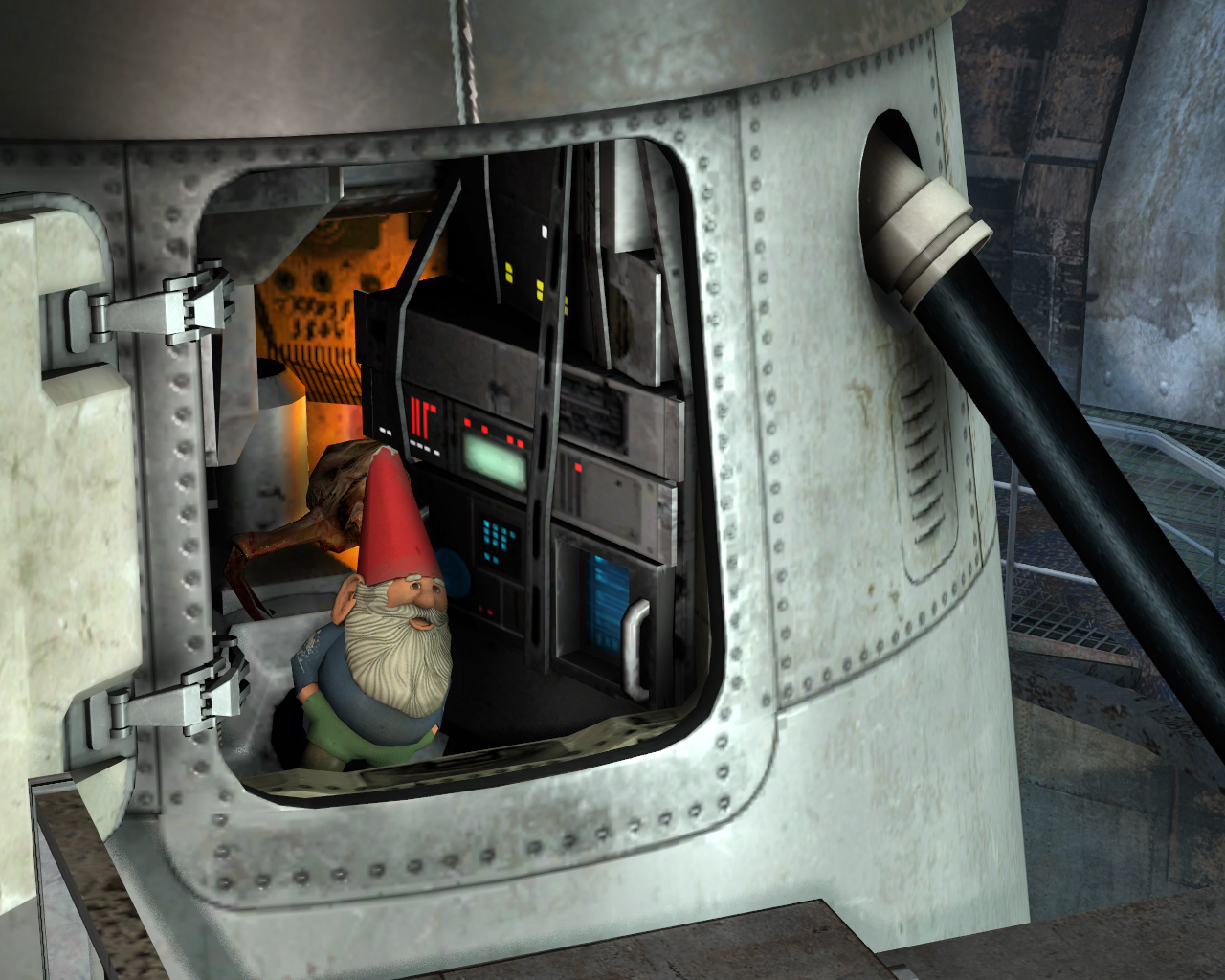I’ve been playing a bunch of Half-Life lately, and I’ve rediscovered that Episode Two fucking rules. I’m not even the biggest Half-Life 2 guy – I love it without being quick to praise the actual experience it provides, but that hardly matters when Episode Two is the best, least compromised Half-Life 2 that ever got made. It has the most consistent level design, the most interesting combat, the most engaging enemy – it teases out all of the latent potential embedded in its framework and carefully works around the fundamental issues therein.
The question is how it does this, which tends to highlight a secondary characteristic of the conversation: Half-Life 2 is such a venerated cultural monolith that people rarely call it on any of the problems that Episode Two is solving in the first place. It’s difficult to articulate why something succeeds when it’s improving upon something you believe to be perfect. I doubt that anyone who worked on Half-Life 2 ever saw it as an irreducible masterpiece; most artists are more pragmatic than their fans, and so they see things less in broad strokes and more as a collection of accomplishments and realizations marked by success and failure in equal measure.
This goes a long way to explaining why Episode Two turned out so well – a game wrapped around a sequence of thoughtful decisions made by a team of people looking at their previous work with a clear, critical eye. But even the act of appraisal itself can’t necessarily be taken for granted.
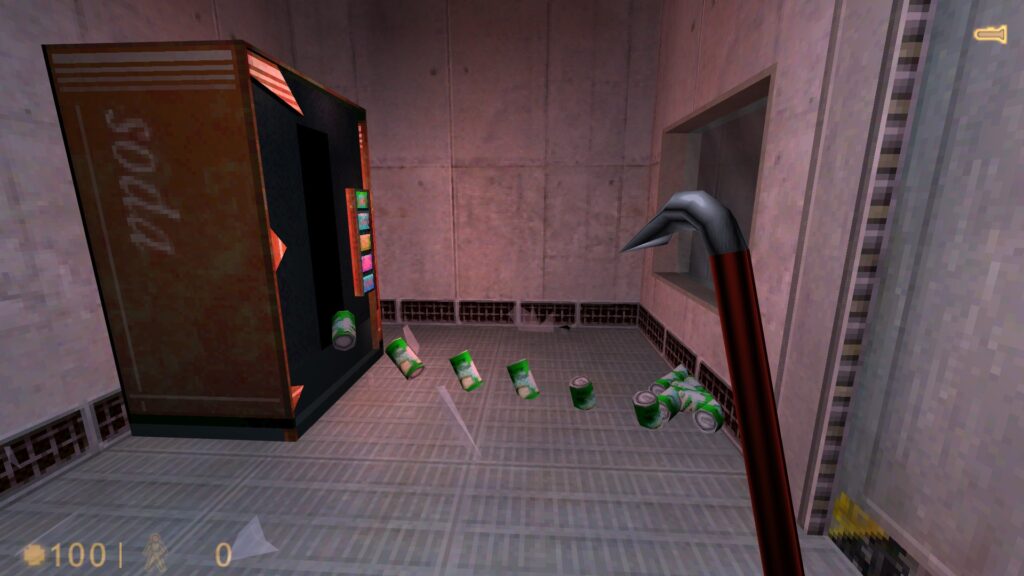
As Valve made the original Half-Life, they accrued a massive base of institutional knowledge, technical skill, and general craftsmanship towards the production of a good Half-Life game. This was proven with Uplink, a tiny pack of amazing Half-Life levels created by a handful of designers who were clearly firing on all cylinders. Uplink is stellar, filled with great encounters and neat scripted sequences – an almost staggering showcase of what makes Half-Life tick. Obviously, this is because they’d just shipped Half-Life! Nobody had to stop and figure out exactly what they were doing because they’d already established what it was. With the clumsiest part of production behind them, everyone could focus their newfound certitude towards the sole goal of making cool stuff.
Shortly thereafter, everyone at Valve stopped making Half-Life and started making Half-Life 2, and while nobody was entirely resetting their brain to do this, it was far from a simple extension of everyone’s prior work. The idea had to be conceptualized from scratch (and then reconceptualized again and again), the technology stack enabling everyone to work comfortably had to spend years coming back online – the Source engine famously spent the majority of Half-Life 2‘s development cycle oscillating between Not Working and Breaking Your Shit – and everyone had to essentially spend five years being foundationally confused amidst a total erosion of confidence and clarity.
Suddenly, being good at making Half-Life became a relatively distinct task from being good at making Half-Life 2. This is a specific instance of a near-universal constant in game development, the unfortunate cycle of which is usually a matter of learning the best way to make what you’re making at such a point when you’re almost done making it. All the tools are online and fully developed, everyone has a great flow, they can articulate the core of what they’re building around – oops, out of time.

The Episodes go a long way to rectifying the tragedies of a development cycle like this. They feel like the product of Valve allowing themselves to stare in the rearview mirror for a while, submitting an idealized version of Half-Life 2 bereft of preproduction vagaries, outside pressures, or the torment of needing to innovate in twelve different areas all at once. They waylaid their typical obsessions for long enough to get everyone focused on producing good levels for an existing videogame; an opportunity to experiment with form laterally, rather than seismically.
Though Episode Two is the better of the pair, Episode One is pretty good by itself. It prefigures the success of the entire episodic project through a number of key choices, the first of which is structural: it established that Valve was essentially going to be making Half-Life 2 in reverse, jumping back from its ending to rewind things in the opposite order. I mean this pretty literally, in that a fully-formed Citadel section precedes a heavily improved sequence of street war chapters. The result is certainly better than what it riffs on, but it’s also fairly representative of the foundational limitations within its component parts. I like Episode One, but it can feel like a necessary primer or prerequisite for a more creatively exciting piece of work.
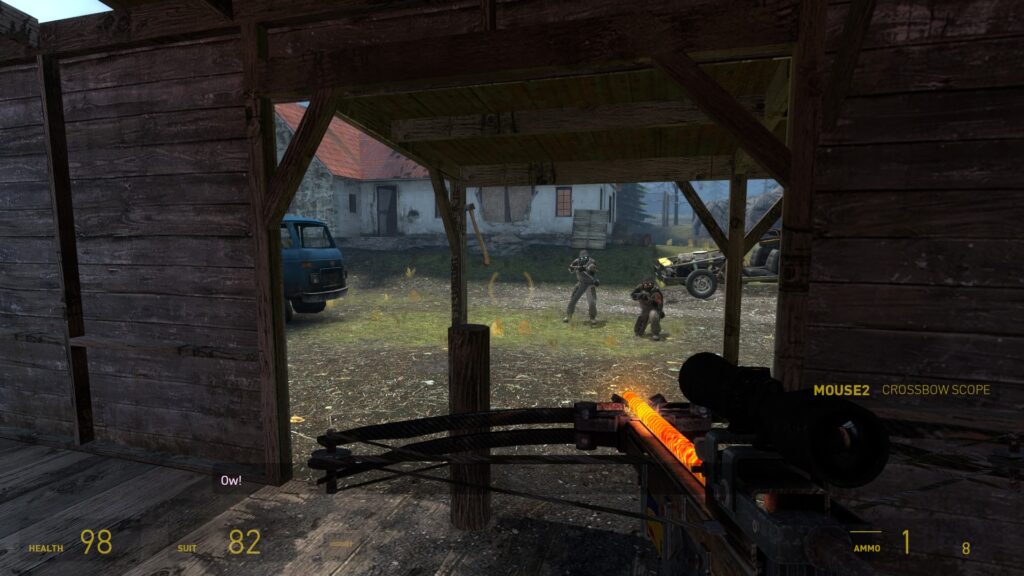
This brings us to Episode Two, which shares a similar structure but with far better pickings to choose from. Half-Life 2 was strongest in the middle, so any game that’s just revising the middle of Half-Life 2 is already off to a great start. The tunnels present a tighter vision of previous antlion-focused chapters (with some turret defense antics for good measure), while the road to White Forest does a really great riff on Highway 17, complete with soldiers that play far nicer than they did on desolate coastal land. Then (having decided that Ravenholm will be somebody else’s problem), you get a fully-formed story diversion in the same vein as Black Mesa East, though it greatly benefits from Episode Two‘s comparative lack of narrative kitbashing.
All of this would be enough, but it also happens to lead into the best, most designed climactic encounter in any Half-Life game; the very first to feel like it wasn’t fucked together at the last minute, such that it has no parallel. It’s the moment when Episode Two, rather than merely improving its predecessor, lays enough solid ground to finally look beyond it. For obvious reasons, this glimpse beyond the design horizons of Half-Life 2 remains as teasing as it was in 2007. But man, what a singular thing.
Valve’s foremost desire to build on Half-Life 2 with their episodic duology is particularly evident in assessing which gameplay elements are entirely new, of which there are very few. These games contain zero new weapons and only a tasteful selection of new enemies. This made them an aberration among typical videogame “expansion” packs, where more was usually their defining principle. They were generally valued less as an experience and more as a commercial good; typically outsourced to a different team, unable to utilize lessons learned via the original game, stuffed with enough new hotness to fill an ad copy. The important thing was how many new guns and how many new enemies they contained, rather than if any of them were good. The result usually spoke for itself.
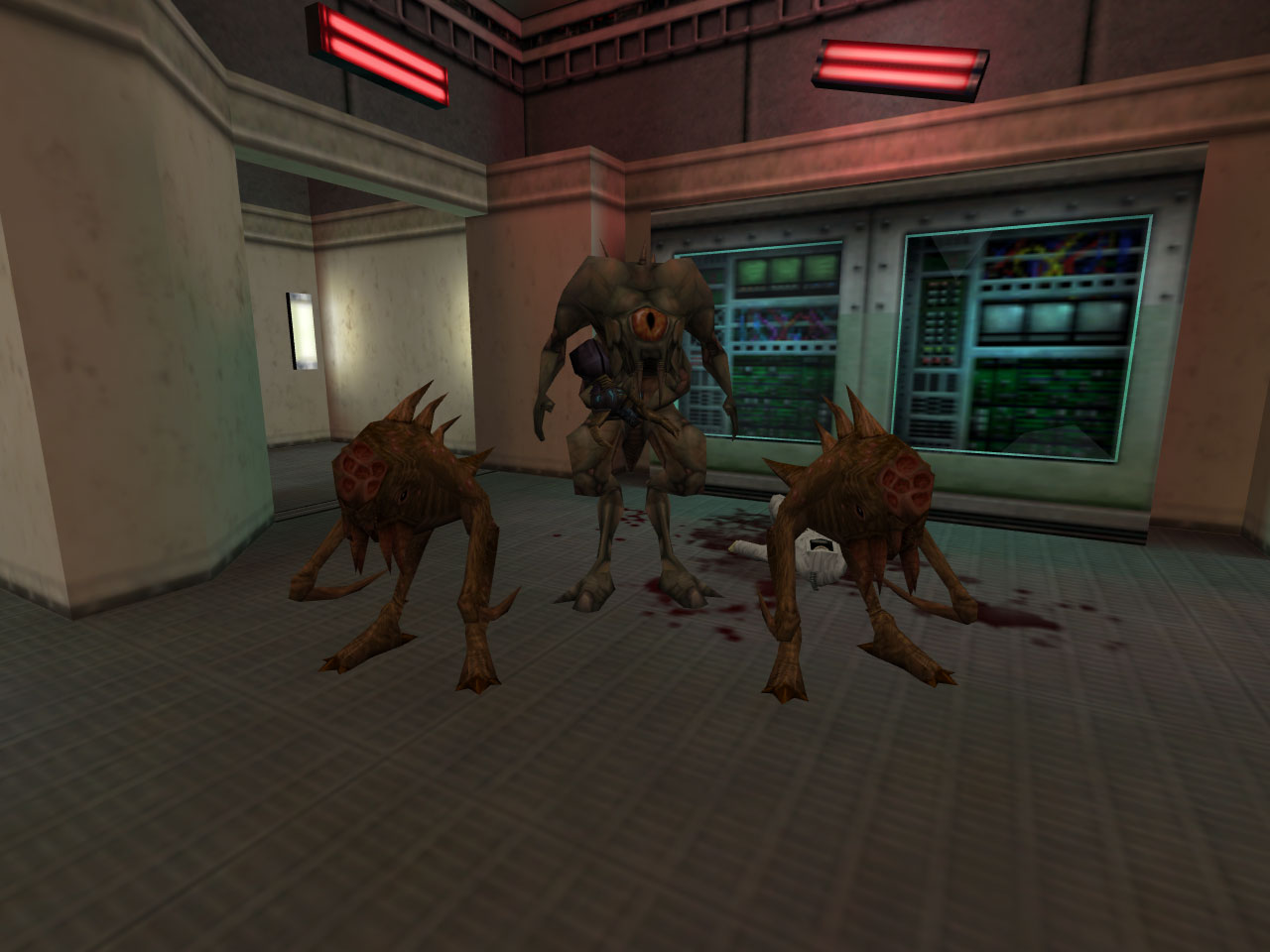
Half-Life’s worst expansion was Opposing Force, which tears itself apart following this exact mentality: a few cool ideas floating across a deluge of bad maps and enemy reskins, bloating Half-Life’s design into an indiscernible blob. The same team later made Blue Shift, which is some of the best commercial Half-Life you can play. The secret? Since it was originally designed for a Dreamcast port, it had to make careful use of base Half-Life materials, essentially forcing everyone to commit to shipping a bunch of great Half-Life levels. And they did! Funny how that happens.
Avoiding this quantitative philosophy allowed the Episodes to solve existing problems and make good of what was already there. With respect to weapons, the recipient of that treatment was the gravity gun. It’s a headlining element of Half-Life 2, but a strangely vestigial part of the design it actually occupies. Using the gravity gun is easy and fun, but it requires neither skill nor creativity; virtually everything dies when you punt a cinderblock at it, and since equivalent objects are almost always around, every problem comes with the same solution. Save the odd moment where you punt a grenade or an energy ball at some soldiers, it never really expands your situational awareness or tests your ability to act under pressure. Environmental puzzles rarely invoke it, and it generally serves to flatten the world into one full of identical victories, rather than filling it with items that radiate with context or meaningful possibility.
What Valve does to finally make the gravity gun interesting involves a combination of compelling setpieces and thoughtful authoring. The former is most evident, since Episode Two is the game that finally creates circumstances where its use is novel, rather than flatly beneficial. There are fights here where the gravity gun feels both exciting to use and possible to use poorly, including a number of fights that leverage existing moments in Half-Life 2. Remember the helicopter that dropped physics bombs on a timer? The moment in the Citadel where you throw balls of dark energy at a Strider? Once Valve turned these things into something, it became impossible to unsee the dormant potential they always had.

There’s a great, inordinately shocking moment in the mines where carelessly grabbing for a cache of supplies sends them careening into the abyss. It’s a joke at Valve’s expense as much as your own; a necessary step back from the autonomic impulses they’ve trained into your brain.
Episode Two feels like it wants to ask how the player could be using the gravity gun, which makes a significant impact. Objects feel partitioned with a special level of care, and level designers seem more willing to play with expectations in a manner beyond showcasing their technology. The gravity gun is a consistent indicator that what Valve finally gained in the production of these games, more than knowledge or clarity, was time. Individual moments feel considered beyond the scope of scrambling towards a minimum viable product for vast swathes of the experience, giving Episode Two a distinct sense of intentionality.
I’ve made it clear how easily this is seen in comparison to Half-Life 2, but it’s important to remember how much solid material was already in that game – it just doesn’t have time to make that obvious. You can tell when the exception applies, like in the generator plaza during Anticitizen One. It’s probably one of the most engaging fights in the game – you feel consistently flanked and pushed upon by individual soldiers building into a rushing crescendo as they gradually advance towards the center of the area. The difference between this single map and any other moment with soldier combat (where the enemies are often placed down with inadequate information about their environment) is absurdly marked. Here, the soldiers are stimulated by the mapper towards interesting behaviour, which makes them interesting! There are plenty of things about these enemies that are flawed at a deeper level, but when a level designer knows how to set them up and has time to do so, the difference is literally night and day.
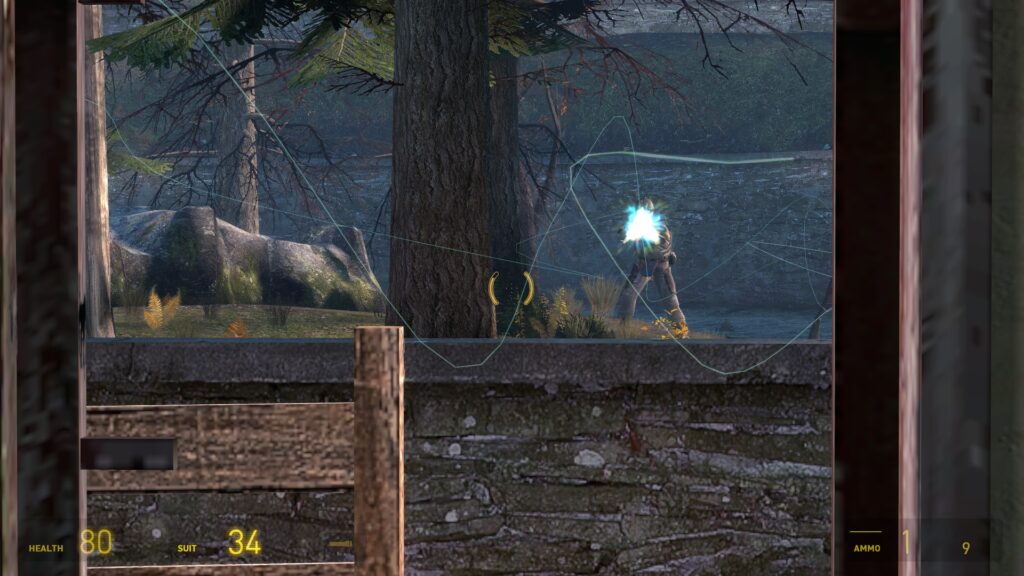
Of course, since time and general skill are in far more abundance, virtually every fight in Episode Two feels like this. The showdown at White Forest Inn is probably my favourite example; the Combine feel like genuine agents operating within a space, and moreover, they feel like they’re forcing you to change your own tactics. In outward terms, this means the level designer has begun using their tools to actually dictate the scope of your behaviour, physically trapping you in a building and requiring you to manage the targets outside. The distance and aggression of your opponents will make certain strategies conducive as others become less appealing. The player can’t control or manipulate the factors being presented, nor can they easily fall into responding in a way that removes any texture from the battle, as they often can in Half-Life 2.
Take the gravity gun, which is utilized excellently here. The building is fairly sparse when it comes to props, which makes sense, since they’re not very useful unless soldiers have already filtered into the room. There is, however, a junk-filled basement that serves as both a reprieve and an appealing place to make last stands. You can bring some of the junk up and punt it at any soldiers storming the inn proper, but it’s an especially useful place for dispatching Hunters, who we’ll talk about soon. Their close appearance usually forces you scrambling down into the basement, which gives soldiers an opening to follow them inside.
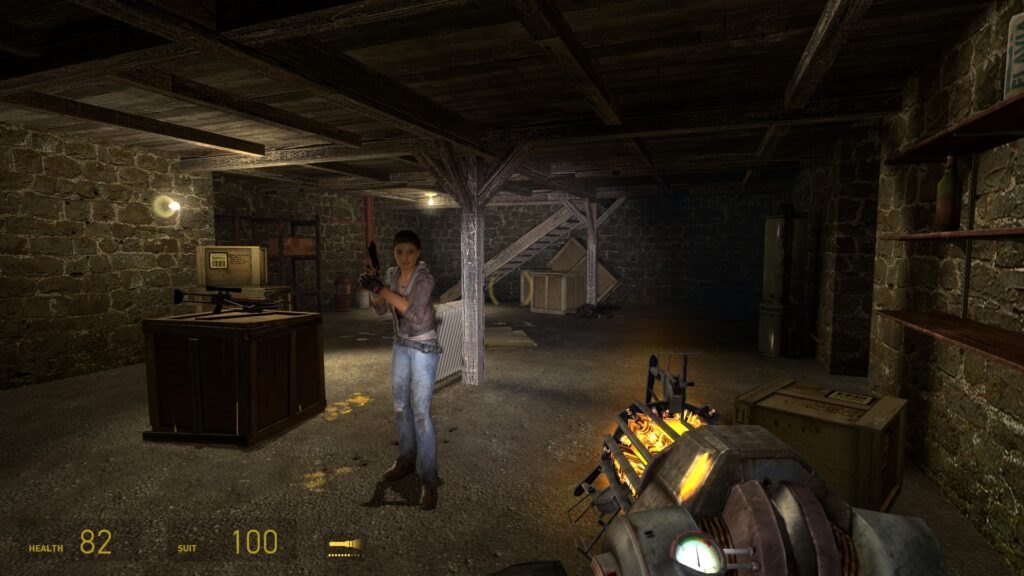
I love this basement because it feels considered in a way that prop placement had only recently started becoming. I mean… it’s a basement! People put miscellaneous garbage down there. You could’ve just as easily scattered a small inn with miscellaneous clutter, but this would only be serviceable instead of good. The gravity gun is a machine that shoots junk, and most people have a physical space in their building for storing junk, ergo you “reload” the gravity gun by visiting the junk room. It’s a spatial reality that requires someone to both understand this fact and properly orient themselves around it. Thoughtful authoring!
Valve loves to curate certain behaviours in the production of engaging design, but until the Episodes, they seemed unwilling to do things within the confines of Half-Life 2 that would disempower the player or force them into an adverse position. The siege at White Forest Inn is a more elegant form of an encounter concept that Valve tries on several occasions throughout Highway 17, all of which suffered from their freeform exploitability. Here, it finally succeeds through the simple act of restricting the player’s movement. Soldiers consistently hold the positional upper hand, similar to Episode One‘s escort finale, and the player feels disadvantaged until they can finally break away from their position and rush the enemy outright. Until then, it’s fun to be cornered!
The concept of friction is well-known game design parlance by now, but its popular application still mostly emerges between the gulf of conventional AAA babying and something like a S.T.A.L.K.E.R. game. Half-Life 2 contains about as much friction as a patch of ice, but that’s because all of its potential stressors exist less as systems and more as potentialities. It has the ability to be almost as abrasive as a designer wants it to be, and once you’re confident enough to desire that effect, the game is transformed outright.
Seriously, flip through these two sequences back-to-back and then consider how many of the same root parts are involved in the construction of either. The lesson? Well, the first is why Combine Dropships stopped making gameplay-oriented appearances. But the second lesson is that targeted player restriction begets the production of interesting gameplay. Pushing is fun, but being pushed is often the difference between genuine excitement and exciting music echoing across a limp arena battle.
I’ve often wondered if Valve was emboldened or inspired by the success of Minerva: Metastasis, a mod for Episode One whose designer they later headhunted. Minerva is one of the earliest mods of its size, and yet nothing about it feels archaic. It remains one of the most successful pieces of game design to ever come out of the scene, which it accomplishes partially by strengthening Combine soldiers with additional health and stronger weapons. They live longer and do more damage, which means they get more time to do interesting things while often forcing you to play interestingly in order to survive.
In addressing this problem, Episode Two doesn’t go nearly as far as designer Adam Foster did – Minerva even removed the gravity gun – but it does seem to understand that even good level design and thoughtful scripting can only do so much for the game’s core enemy type. To address this, Valve created a new one.
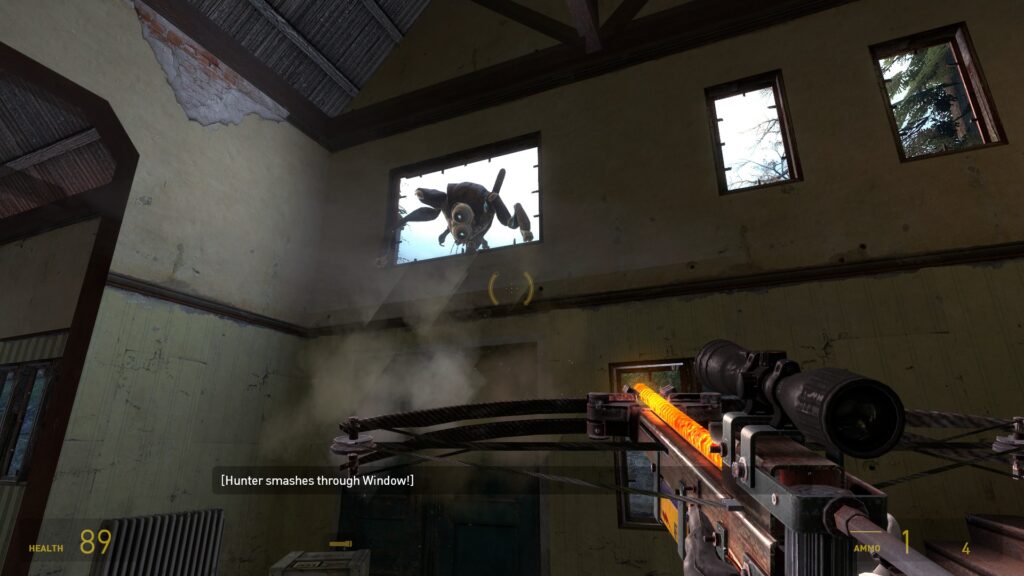
Hunters are Episode Two‘s major addition to the enemy roster and are, without question, one of the best enemies to be found in any first-person shooter. They represent a ton of the latent greatness embedded within the margins of systems and interactions that Half-Life 2 either doesn’t utilize or never reconciles into something good. They’re interesting, pushy, frightening, unique, and completely simpatico with every aspect of the game they occupy. Purely spectacular.
Hunters call to mind the soldiers in the original Half-Life, and are ultimately good for a few of the same reasons. They feel physically reactive and simultaneously emotive, capable of overstepping or working themselves into organically dangerous situations. Cinematic spectacle adds a ton to their presence in Episode Two, but compared to most of the Combine’s synthetic menagerie, they need minimal work to be made interesting – even the bad Half-Life 2 mods I’ve played struggle to have bad Hunter fights.
Where the Hunter really amazes is in its tackling of a certain physics problem. We’ve already talked about how the gravity gun flattens most encounters in Half-Life 2, which is a dilemma Episode Two admirably (and largely) solves. But as a medium-sized enemy, the Hunter litigates certain problems that Half-Life 2 sidestepped in its awkward treatment of the Antlion Guard. “What purpose does the gravity gun serve when an enemy is bigger than a soldier, but smaller than a Strider?” you can hear the designers asking. A medium-sized enemy is usually small enough to throw tires at but bulky enough to make doing so ineffective. Should it be totally ineffective? Simply removing these items isn’t very ideal, since these enemies can often knock objects around in a fun way. In Half-Life 2, they solved this problem by filling the arenas they occupied with auspicious explosive barrels. Ultimately inoffensive, but not particularly great.

Hunters take a more holistic, programmatic approach. Their design is a little more conducive to resolving the efficacy of throwing logs at them, being large with a more concentrated center of mass. Physics will kill this enemy, which is clear the moment you satiate the urge to hit one with your car. In fact, they’re usually easier to kill with physics than gunfire, though gunfire isn’t rendered totally ineffective; weapons like the crossbow or revolver retain their capacity for quick murder if you can land your shots.
The resulting glass cannon has a really unique presence on the battlefield, since certain elements can turn the tables relatively quickly. You won’t kill every Hunter with the gravity gun, but you’ll usually kill most of them with some combination of punted objects and conventional weaponry. In particular, the mass of a launched object suddenly feels important in a way it rarely did against human targets. This is one way in which throwing things at Hunters feels like expending a resource or utilizing your brain in order to solve a problem. Pretty much everything larger than a can could reliably kill things in Half-Life 2, but Hunters suddenly make the gulf between a piece of trash and a metal barrel incredibly clear. Since the player has to reconsider their usual gravity gun usage, relying on it becomes a process of acclimating to the newfound rhythms of combat. Often, it feels better to throw something, shoot, then throw something else.
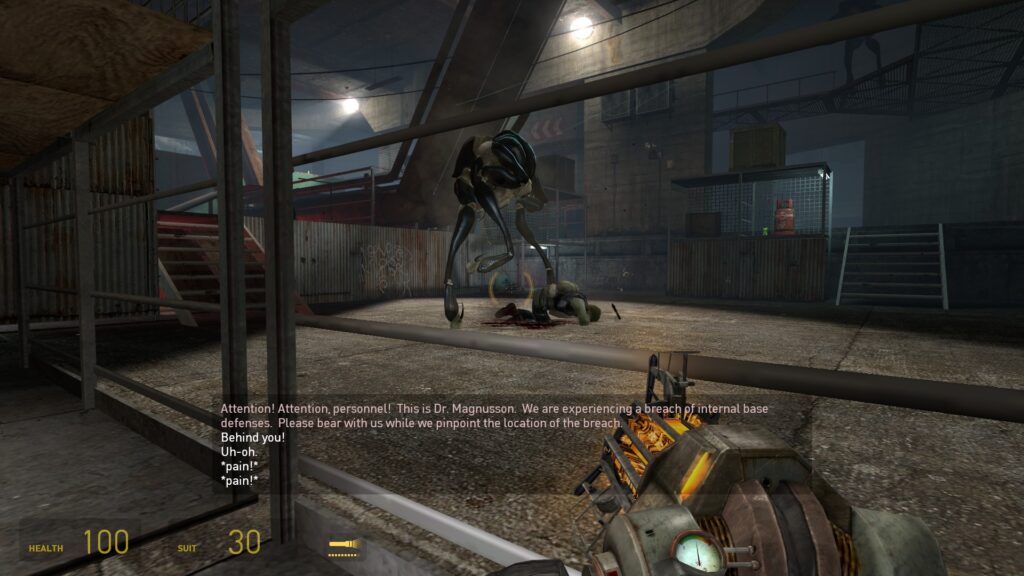
But I think my favourite aspect of the Hunter is entirely optional: there’s a way to kill one instantly. An achievement hints at the strategy, but you may stumble across it yourself. The trick requires you to get a Hunter to embed its flechettes in an object, only for you to launch that same object towards it at the exact moment when the flechettes detonate. This disintegrates it! You can theoretically do this wherever a Hunter is present, but the timing is fairly hard. To do it without prolonging a fight requires legitimate mastery over a set of considerations the Hunter suddenly presents: when do the flechettes detonate? what’s an object in my vicinity with a surface area they can easily land on? how much time will pass in the interval between the object I’m flinging and the target it’ll hit?
In a rare and appreciated break from tradition, Valve doesn’t tutorialize this. Like, at all. You could easily kill every Hunter in the game without learning how to do this, which is a clear indicator that this kind of mastery is optional, serving as an extension of the combat rather than a fulcrum. I often love this approach to designing an enemy with a built-in weakness – you can easily finish a Halo game without relying on strategies like killing Elites to send other enemies into a panic, but those interactions are precisely what makes the AI interesting after you’ve already seen them performing their most obvious tricks.
Hunters turn actions that would otherwise trivialize them into an interesting puzzle you solve in the midst of combat. Often, I’ve found myself saving as one appears only to reload after killing it. I like to test them in different ways, seeing what I can do differently. I’ve played Half-Life 2 enough to be sick of it, but even the mere presence of Hunters makes Episode Two – the extension of a famously artificial game – feel exciting and alive.
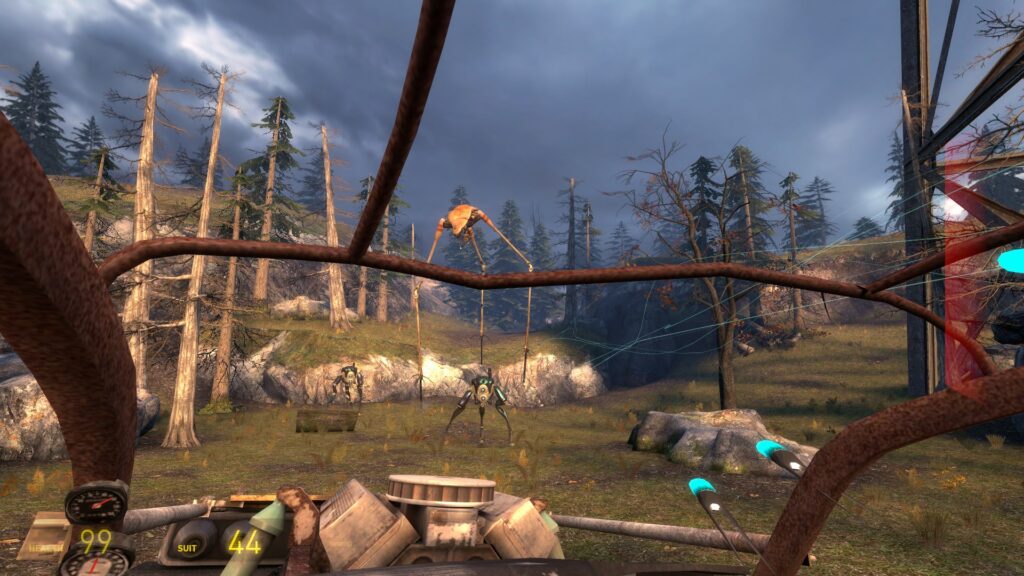
The sum total of everything we’ve discussed – an intelligent approach to physics, a greater fluency in encounter design, and even the Hunters themselves – brings us towards the defense of White Forest. It succeeds in the same way that something like Halo‘s The Silent Cartographer succeeds, representing the best moment in the game alongside its platonic ideal; the moment you would isolate above all others to represent the heights of a discipline or design. Levels like these utilize their surrounding framework to exceed what it can regularly accomplish, practically carving out their own space in the process. This one, like all others, is a masterpiece.
An entire breakdown of this sequence would run long enough to be its own article, so I’ll settle for broad strokes here: Striders, flanked by Hunters, walk along specific paths towards a game-ending point. Magnusson devices can be used to kill Striders instantly by launching them towards their carapace, detonating them with a gunshot when they attach. These devices can be acquired from several structures along the aforementioned paths, and if any Strider reaches one of these structures, they’ll blow it up and remove that particular Magnusson spawner. Moreover, any living Hunters will use their flechettes in a (very successful) attempt to deny any Magnussons before they can be detonated, requiring you to kill a Strider’s entourage before the Strider itself.
This section reconciles another tricky element that Half-Life 2 struggled to make consistently good, that being the Strider itself. These enemies are similar to the G-Man, in the sense that Valve tends to pull them out when the game is nearly over and they’re running short on things to do. Don’t get me wrong, Striders are great… sometimes. They’re certainly fun to watch, and they’re exciting in the abstract. Unfortunately, they suffer greatly (this is a recurring theme) from being dropped in without suitable tuning or even just a polished setpiece to occupy.
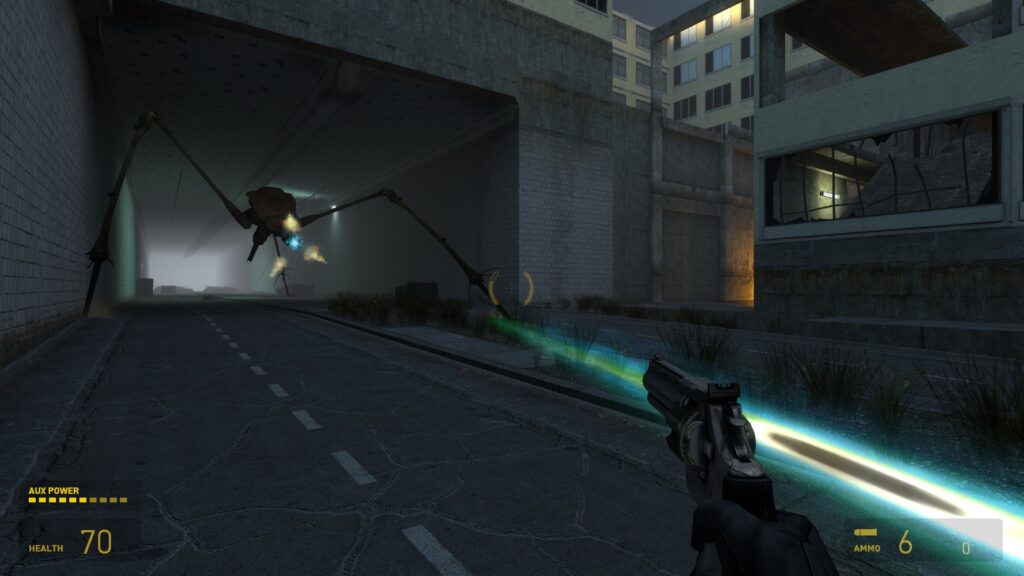
Striders are chiefly a Spectacle Generator, but their placement towards the game’s end did little to service that. There wasn’t much time left to craft bespoke scenarios for them to partake in, and the few that occur are consistently slapdash – one blows up a big wall and chases you through a tunnel full of overturned dumpsters into a dilapidated building set inexplicably far into the ground. But even beyond a lack of surrounding polish, Striders are magnificent in motion and fairly unengaging to actually fight. Their simulated grace immediately collapses within the confines of an actual battle, and killing them always feels a little bathetic; they tend to lose their majesty and raw animal brutality in the service of awkwardly flopping to the ground after tanking six to eight rockets.
Episode One attempts to solve this problem by deploying the enemy as a stationary turret guarding a box of rockets, which is fun enough, since it turns gaining the ability to kill one into the substance of the encounter. At the same time, I can’t shake the feeling that cooping one up like this is animal abuse. The ideal Strider is on the move and tearing shit up, not trapped in a small arena with a dragon’s hoard of explosives. But how do you make that work beyond securing enough time to animate some cool destruction sequences?
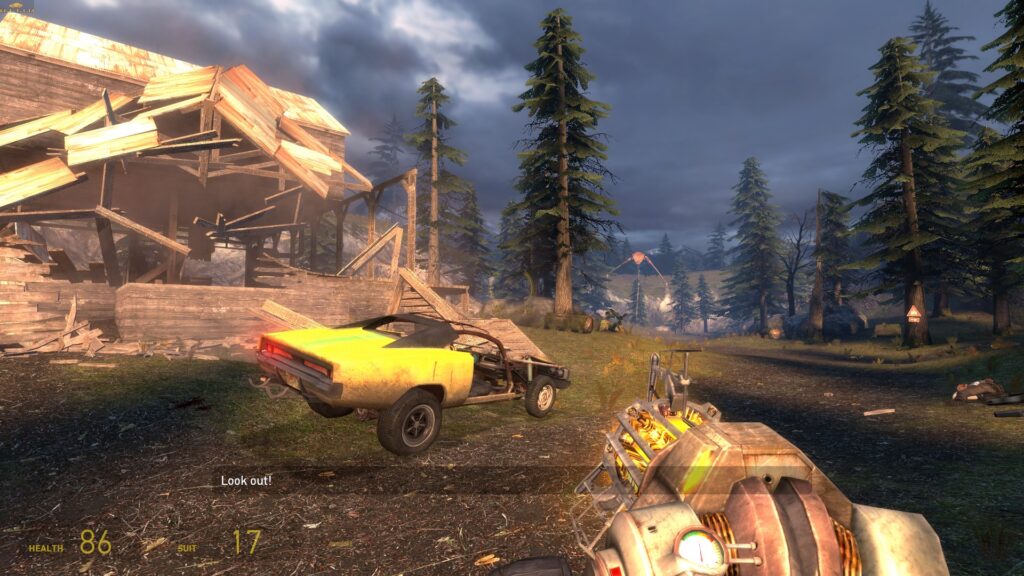
In Episode Two, Valve finally leverages Striders as the big brick shithouse enemies they are, leaving them free to sprint around gracefully detonating stuff without worrying too much about the player. They’re still unambiguously Spectacle Generators, but they’ve become flanked by engaging gameplay machines in the form of Hunters, which offloads the onus of them needing to be good on their own terms. Still, I would never guess that Magnusson devices, which kill them instantly, would resolve the dilemma of their intrinsic anticlimax. It feels like an anti-solution, right? But it works because you’re not actually fighting the Striders, though your brain never perceives it that way.
Instead, you’re just fighting Hunters, who are predictably the real stars. They’re assigned to corresponding squads with an assigned Strider escort, and since they stand between you and the successful deployment of a Magnusson, killing them is a necessity. If you’ve ever played Team Fortress 2, they’re basically the mercenaries defending the Payload cart. The cart generates tension by moving forward such that you still perceive the cart itself as the thing you’re stopping, rather than whoever is pushing it. Episode Two uses this effect to make you feel like you’re fighting Striders and Hunters, hiding the least effective aspects of the former by foregrounding the latter.
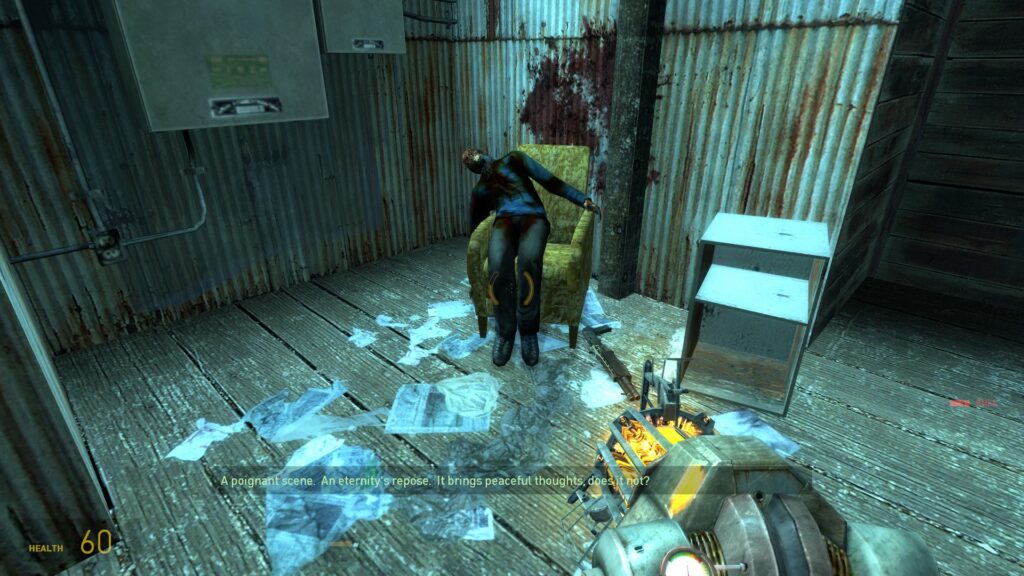
In articulating what I like about Episode Two, I’ve ultimately had to determine the core aspect of Half-Life 2 that really bothers me. You’ve probably intuited that I’m not a fan of its heavy reliance on illusions, but that idea by itself is meaningless. All games are, to a degree, a showcase of smoke and mirrors; of making you perceive what isn’t really there. Consequently, all games are built on load-bearing mirages which vary in their significance and intent. Some are smart, some are dumb, some are obvious, and some are expertly hidden. But when do these mirages become detrimental to the production of good, compelling work?
Illusions can serve to focus or flatten, but a bad illusion will always do the latter. Half-Life 2 is a suite of psychological trickery and quiet deception, and what rankles me is that so many of these cheats are actually cheating the experience itself more than your perception of it. It has plenty of good illusions for the specific aims of the experience, like when an npc_bullseye directs a soldier’s gunfire to make it seem like they’re ambushing you in a certain way, even if the soldier doesn’t actually possess the information those shots would suggest. The emotion that emerges from the resulting pressure is as important to that particular experience as the stage directions in a play, and without them, texture would be lost.
But when waning development time forces you to balance the flow of resources across the entire game by deploying a program that gives the player whatever they need, the resulting illusion abdicates the role of the designer entirely. The illusion becomes a substitute for something real, like performing an intimate task by hand, and it becomes scattered into every corner of the game until it’s completely load-bearing. The method is secondary to the result, and here, the result weakens everything around it like the cheap substitute for a structural support that it actually is. It’s a bad illusion, flimsy and tawdry and stretched too thin, hiding nothing behind the curtain except the absence it belies.
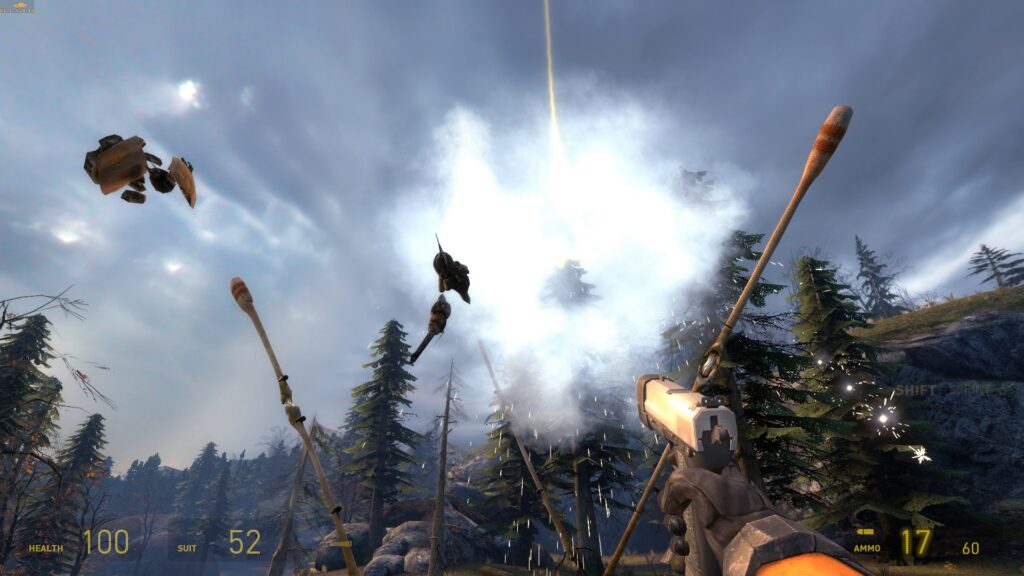
I think this sequence is a microcosm of how a game like Half-Life 2 ought to be made. The defense of White Forest is similarly full of illusions: Striders won’t blow stuff up if you aren’t looking, and only a choice handful are set to destroy buildings in the first place; health is positioned near doorways so you’re more likely to pick it up automatically, even in the midst of a battle. The entire battle was tweaked over months and months to make all sorts of things feel smoother, and the result clearly shows in that resulting emotional manifold. The illusions work to ensure that you’re panicked, excited, and frustrated at the same time. There is friction, triumph, drama, and feeling amidst every touch, invisible or otherwise.
If we go back further and look at the inn siege, we’ll find that it isn’t even dangerous. It self-admittedly isn’t meant to be, with a commentary node describing it as a “controlled” encounter designed to showcase interesting enemy behaviour in an unscripted way. You can sit in the basement only to realize that none of the soldiers will storm their way inside until certain conditions are met. Even Hunters have plenty of map-specific arguments and theatrical displays – you can read their code and see most of them outlined clearly.
These things feel like they exist, like Episode Two itself, to make good of what’s already there. The invisible, guiding hand feels less like a steamroller and more like a curator, supplementing good art instead of anxiously overcorrecting it. Games are good for different reasons – I’ll never like these, even at their best, for the same reasons that I like the original Half-Life. All the same, I love Episode Two for harmonizing something I cautiously love with a design that was never healthy for it. It leaves me without the desire to tear away at things to see what might be suffocated underneath; something compelling is already visible on the surface.

